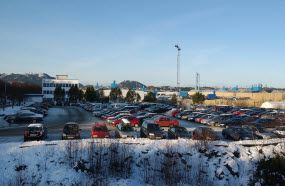It is unusual for the Pollution Act to be cited in damages cases, but this is just what happened recently:

|
Rolls Royce Marine's factory in Bergen. |
Morten Onsøien at SINTEF Materials and Chemistry tells that the scientists travelled to Bergen in order to look at the situation there.
“About 70 vehicles were involved. Ther paintwork was rough and covered in tiny flecks of rust, and it was reasonable enough to suppose that these came from dust emissions from the factory”, says Onsøien. The scientists had samples sent to Trondheim, that were removed for closer study.
“We were also inside Rolls Royce’s foundary and took samples of their casting sand in order to compare it with the spots on the cars”, says Onsøien.
The SINTEF report was able to confirm that the dust had attached itself to the paintwork while the cars were standing in the company’s car park. The dust contained metal particles and corroded the paintwork, with the result that the grains of sand seemed to have “stuck fast” in it.
Since the employees never received a proper answer from the company, they decided to take it to court, and used the SINTEF report as scientific documentation to back up their claims.
Bergen District Court ruled that Rolls Royce should pay for the damage, as well as NOK 214,000 in costs to their opponents.
Contact:
